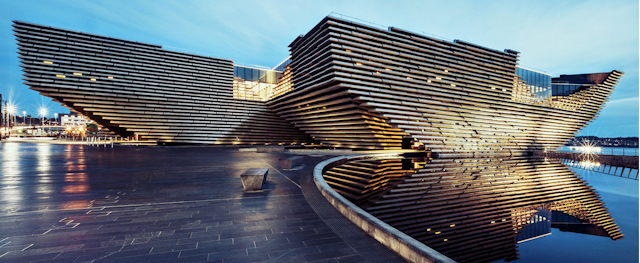Glowing from enthusiastic reviews and well-deserved plaudits since the spectacular Kengo Kuma building was unveiled in September 2018, the V&A Dundee – the first V&A outside of London – has much longer standing connections with the city than many people realise.
Billed as Scotland’s first design museum, the building houses a permanent new Scottish Design Gallery and space for circulating exhibitions. Discovering this hidden history helps reflect on this new V&A, the stories it tells and the stories it chooses to leave out – chiefly, why a gallery dedicated to telling the story of Scottish design, focuses only on the past 600 years.

Published to coincide with the opening of the new V&A, The Story of Scottish Design acknowledges more than 5,000 years of Scottish design history. The gallery includes accomplished objects whose design consciously references Scotland’s earlier heritage, such as a George Bain carpet, an Alexander Ritchie firescreen, and metalwork designed by John Duncan – all showcasing the two Celtic revivals of the late 19th century and post-war period after 1945.
In A Living Room for the City (as Kuma described the new museum), V&A London director Tristram Hunt notes an important historical connection to Queen Victoria and Prince Albert – after whom the V&A is named – thanks to her love of Scotland. In 1844 the royal couple made a visit to Dundee during one of their early trips to the Highlands. And it is in the 19th century that the reasons can be found as to why the museum has decided not to provide the full history of Scottish design.
The strengths of the V&A’s own Scottish collection, which have shaped today’s Scottish Design Gallery, lie in the period from the 15th century to present. This reflects the ethos of the 19th-century V&A. However, my research shows that Dundee and the V&A have a history that goes back to the late 1880s – which did embrace earlier Scottish design from the 8th century onwards. To understand why this material might not be present in V&A Dundee, we need to look at the history of creating and circulating replica artefacts, and what has happened to them since.

V&A beginnings
The V&A was originally established to improve the design of popular manufactured goods, by providing suitable models for artists and others needing technical training. Native prehistoric design was not a part of that preferred 19th century design repertoire, but post-Roman Christian Celtic art styles burst on to the scene in Owen Jones’s influential Grammar of Ornament (1856), an illustrated book of world designs intended to improve the repertoire of craftspeople.
The South Kensington Museum, as it was then known, acquired just two examples of Scottish early Christian art, still on display in the V&A – a decorated Pictish cross slab from Nigg and the Anglo-Saxon Ruthwell Cross. These were plaster casts, for replicas that could be circulated among international museums were the in thing 150 years ago.
Antiquarians made efforts to interest curators in acquiring more casts of early and later medieval Scots sculptures, but were rebuffed. As Gerard Baldwin Brown, Professor of Fine Art at Edinburgh University noted in 1902, the V&A was “not a place where national self-love is flattered”.
Out in the provinces
While the V&A did not invest much in earlier Scottish material for itself, it supported Scottish museums in copying Celtic sculptures that might inspire local artists to improve the design of gravestones, for instance.

At the turn of the century, in other parts of Scotland, Dublin, Cardiff and the Isle of Man, there was a strong interest in acquiring collections of Celtic crosses. Serious scholarship on these monuments was just maturing and the regionally distinctive sculpture spoke to an awakening sense of national identities.
The V&A supported the creation of such collections as part of the package of loans, grants and advice to provincial museums delivered by its circulation department to newly founded operations in Glasgow, Dundee, Paisley and Aberdeen (in Edinburgh the Royal Scottish Museum originated as a branch of the V&A).
The V&A in Dundee then and now
As the 19th century ended and the 20th century began, Dundee’s curator John Maclauchlan was highly appreciative of the V&A’s support. Between 1894 and 1917 V&A staff visited and advised on annual loan collection displays, educating teachers about new exhibitions, and giving lantern-slide lectures to the public. The Albert Institute (now The McManus) had begun acquiring plaster casts of sculptures and other types of reproductions, including the Elgin Marbles. In 1904, Dundee acquired casts of some of the finest Celtic crosses in Scotland.

Visitors to Dundee’s new V&A will hopefully get a chance to visit the McManus Gallery whose earlier history is bound up with the V&A in London. While a plaster cast, particularly a Scottish Celtic subject, might today have spoken for that earlier relationship, none of Dundee’s V&A-assisted collection now survives (although equivalent collections do in Glasgow’s Kelvingrove and Aberdeen Art Gallery.
The evolution of the collection in London has framed the chronological breadth of V&A Dundee’s Scottish Design Gallery. The point is not to criticise, but to promote awareness and debate. V&A Dundee should have a profound impact for generations on how people living in Scotland and international visitors alike perceive the pedigree and value of Scotland’s extended design history. How the institution realises its aims depends upon both vision and accidents of its history.

